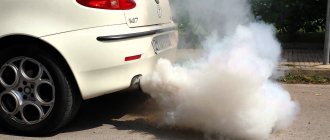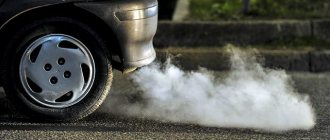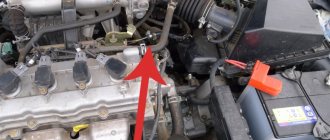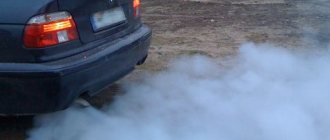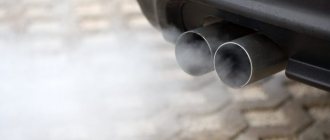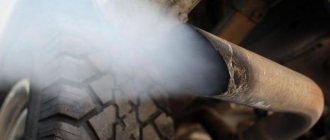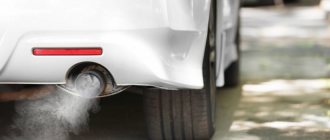Most drivers are accustomed to the fact that in warm weather the car practically does not smoke, but in cold weather this is a normal phenomenon. But when in the summer intense smoke of white, gray or black shades begins to pour out of the chimney, not everyone is able to understand what is happening. Although most still realize that this behavior of the car is a clear sign of problems. In fact, a change in the color and intensity of the exhaust can really tell a lot, but since in each specific case there can be many reasons, it is worth talking about this in more detail.
White smoke from the muffler - what is it?
A car - a harmonious system of components and assemblies - like a living organism, sends signals to the owner about various types of malfunctions. However, not every owner reacts to such a “trifle” as thick white smoke from the exhaust pipe of a gasoline engine. Meanwhile, the color of the exhaust, the frequency of the phenomenon (short-term or frequent) are harbingers of serious repairs: sometimes it comes to capital.
Exhaust gases consist of water vapor and many chemical compounds, the main ones being a mixture of nitrogen and carbon dioxide. Before being released into the atmosphere, spent substances are purified in a catalyst.
Why is white smoke from the exhaust pipe dangerous?
If the car is in order, the gases are colorless. A small cloud of whitish smoke when the power plant is cooling, as well as when starting the internal combustion engine in cold weather, should not bother the driver. Rather, steam is released: water, a byproduct of gasoline combustion, condenses in the cold exhaust tract and becomes visible. This picture is considered normal.
It’s worse when a dense white trail trails behind the car on a warm day, and the engine is warmed up to operating temperature. Analysis of the phenomenon in most cases indicates technical malfunctions of the vehicle.
Exhaust gases and their normal color
Exhaust (exhaust) gases are formed as a result of the combustion of fuel in the engine cylinders, which are released into the atmosphere through the vehicle's exhaust system. The composition of exhaust gases largely includes nitrogen, oxygen, water vapor and carbon dioxide, and also contains various carcinogens in varying proportions, such as benzopyrene, soot and sulfur oxide.
Exhaust gases
When the engine is in good working order, the exhaust gases have a light gray, almost transparent color. This is subject to certain observation conditions:
- the engine is idling;
- the engine is warmed up to 60-70 degrees;
- Observations are carried out during daylight hours.
Steam or water droplets may be observed when the engine is not warmed up. This is a normal phenomenon associated with condensation inside the system and the way the catalyst operates.
There are three colors or shades of exhaust gases that indicate certain problems in the engine:
- White smoke;
- gray or blue;
- dark gray or black.
Sometimes the smoke may acquire a reddish tint as a result of the use of various additives or gentle washing, but this does not apply to malfunctions.
The main reasons for the appearance of white smoke from the exhaust pipe of a gasoline engine
It is important to be able to distinguish between harmless water vapor and smoke itself. The steam easily, without a trace, disappears into the air, while the smoke turns into an oily bluish fog behind the car. Let's consider the causes of white smoke from the exhaust pipe of a gasoline engine in order to correctly estimate the costs of restoring the mechanisms and systems of the car.
Leaking coolant cylinder
Drivers consider the cylinder block to be the most important component in the design of a car, which always requires attention.
The BC can depressurize for several reasons:
- gasket burnt out;
- the cylinder head was deformed due to improperly tightened nuts;
- A crack appeared in the cooling jacket of the unit.
The last trouble occurs due to the negligence of drivers who add cold water to a hot engine or defrost the unit when the thermometer is very negative. Antifreeze gets into the cylinders of a leaking block: white smoke comes out of the muffler. Other symptoms also appear:
- the motor lubricant becomes cloudy, a light yellow-brown emulsion appears in it, which is easy to notice in the filler neck;
- bubbles form in the expansion tank;
- the spark plugs get wet, smell like antifreeze, but sparkle like new: the working fluid cleans the parts perfectly;
- the power unit is tripping.
Causes of light white smoke
The danger of coolant leaking into the cylinders is that ethylene glycol (a component of antifreeze and antifreeze) mixes with the engine lubricant and forms solid particles. The latter, acting as an abrasive, destroys parts. And the lubricant loses its qualities. Taken together, these circumstances put the entire unit out of working order.
Injector malfunction
Both cars with injectors (Toyotas, Renault, Peugeot) and equipment with carburetors (motorcycles, walk-behind tractors, scooters) smoke.
The causes of white smoke from the muffler are as follows:
- the supply of the air-fuel mixture or the operation of the gas distribution mechanism is disrupted, which leads to incomplete combustion of gasoline;
- components of the cylinder-piston group are worn out;
- There were problems with engine cooling.
The last reason is the most likely for injection engines. Additionally you will notice:
- increased fuel consumption;
- oil zhor;
- floating speed;
- Difficulty starting an unheated unit.
The smoke from steam in injectors is characterized by high density, the smell of burnt oil, and long dissipation. It’s a completely alarming signal when the smoke does not disappear after the car warms up.
White smoke due to condensation
The exhaust tract, after standing overnight, becomes covered with drops of moisture. Condensation actively forms on metal in cool weather, when the thermometer is below +10 °C. High air humidity also contributes to the appearance of moisture in the muffler.
During the morning warm-up, the components of the exhaust system become hot, the exhaust gases mix with droplets of water, forming steam. As the condensate evaporates, the white smoke disappears.
Low-quality gasoline with foreign impurities
Some drivers save on gasoline or diesel and fill the tank with cheap fuel at dubious gas stations. So you risk paying for water that will freeze in winter and seal the fine mesh of the fuel filter, plus excess sulfur. In the combustion chambers, the substance turns into sulfur oxide, then, mixed with water vapor, into sulfuric acid. The consequences for the engine will be catastrophic.
The octane number in “left-handed” gasoline is not controlled, causing destructive detonation. And it contains toxic benzene and aromatic carbohydrates, which increase carbon deposits and “eat” rubber and plastic. Alcohols and ethers create air pockets in fuel lines.
Why does the chimney smoke white?
The following systems suffer from low-quality gasoline: intake-exhaust, fuel supply, exhaust, ignition. In addition to detonation, poor car starting, loss of power, you will hear knocking in the engine and see a darkish exhaust in the rearview mirror.
Oil burnout due to the presence of rings (smoke with a tint)
Remaining engine oil from valve stems and cylinder walls is removed by valve stem seals and rings. Worn rings become stuck, so excess lubricant burns out.
At the initial stage, the defect is noticeable when climbing uphill with the gas pedal pressed halfway. A bluish haze appears and quickly dissipates. In critical cases of oil scraper rings, smoke accompanies the car constantly, most of all when accelerating.
Moisture getting into the cylinders
By “moisture” we mean coolant. Look for the reasons why white smoke is coming out of the exhaust pipe in defects in the block or cylinder head. Most likely these are cracks.
For an accurate diagnosis, remove the cap from the expansion tank and start the engine. Now examine the fluid for oil stains and a specific exhaust odor. The detected signs indicate microcracks or wear of the BC gasket.
Blue or gray smoke
The most likely cause of blue (“oil”) smoke is oil getting into the engine cylinders. “Oil” smoke can have different color shades: from transparent blue to thick white-blue. This depends on the operating mode of the engine, the degree of its warming up and the amount of oil entering the cylinders, as well as lighting and other factors. It is noteworthy that oil smoke, unlike steam, does not dissipate quickly into the air, and the paper test mentioned above produces greasy droplets flying out of the pipe along with the exhaust gases. It is also obvious that oil smoke is accompanied by increased oil consumption. Thus, at a consumption of about 0.5 l/100 km, bluish smoke appears mainly in transition modes, and when it reaches 1.0 l/100 km, also in uniform motion modes. By the way, in the latter case, during transient conditions, oil smoke becomes thick blue-white. True, owners of the most modern cars need to remember about the possible presence of a neutralizer that can clean the exhaust gases from oil even at fairly high costs.
Oil can enter the combustion chambers (cylinders) in two ways: from below, through the piston rings, from above, through the gaps between the valve stems and guide bushings. The most likely reason for the appearance of blue exhaust is wear of the cylinder-piston parts. The upper compression rings experience wear not only on the outer surface in contact with the cylinder, but also on the end planes that perceive the gas pressure in the cylinder. The grooves of these rings in the pistons may also be worn out. Large gaps in the grooves create a pumping effect. Even if the oil scraper rings are still normal, oil still enters the cylinders, since the upper rings continuously “pump” it from the bottom up.
Cylinders wear out the most in the stopping zone of the upper ring when the piston reaches top dead center, and in the middle part they often take on an oval shape. Deviation of the cylinder shape from the circle impairs the sealing properties of the rings. Gaps usually form in the area of the locks, but it is possible that they may appear in other places around the circle.
There are cases when, although the ring and piston are in relatively good condition, the cylinder surface is damaged. This happens, for example, when oil filtration is poor, when abrasive particles get between the piston and cylinder skirts, resulting in scratches on the cylinder. A similar situation is real after a long period of parking, when traces of corrosion may appear on the surface of the cylinders and rings. It will take considerable time to smooth out these defects and to mutually break in the parts (if they can break in at all).
The same effect often occurs when engine repair techniques are violated, when the surface of the rebuilt cylinder is too rough or the cylinder is of the wrong shape, or they used poor quality pistons or piston rings that do not meet the engine specifications. In such cases, normal engine operation should not generally be expected.
Wear of the cylinder-piston group is often accompanied by a loss of compression and an increase in pressure in the crankcase, which is determined by the corresponding devices (compressometer, leak tester, etc.). However, remember that a large amount of oil entering the cylinders well seals the gaps in the mating parts. If the gaps are not too large, then the result of the compression assessment can be quite normal, sometimes even closer to the upper limit. It is this circumstance that confuses the search for specific causes of oily blue smoke.
When there is no significant wear of parts, then blue or blue-white smoke is clearly observed only when the engine is running in warm-up mode, gradually decreases and even disappears altogether. The reason is simple: when heated, the parts expand and occupy more space, in which they are pressed harder against each other. If there is excessive wear, the picture is the opposite: the amount of smoke on a warm engine will increase, since it is easier for hot oil, which has a low viscosity, to enter the cylinder through worn parts.
It is always easier to identify a fault if it is associated with more severe forms of wear or even broken parts. Thus, significant detonation can occur, which leads to damage to the bridges between the rings on the pistons, at least damage to the rings themselves is most likely. Severe overheating of the engine causes deformation of the piston skirt, creating a large gap between the piston and the cylinder. A deformed piston warps, disrupting the operation of the rings. The same result is possible when the connecting rod is deformed, for example, due to water hammer when water gets into the cylinder or after a belt breaks and the piston hits an open valve.
Using low-quality oil can lead to ring burnout or sticking in the piston grooves. The use of low-quality oil can cause the rings to burn and stick in the piston grooves. And due to prolonged glow ignition, the rings can simply be rolled into the grooves with a complete loss of mobility.
The above defects usually do not occur in all cylinders at once. It is not difficult to find a faulty cylinder by comparing the condition of the spark and compression plugs in different cylinders. Moreover, such defects are often accompanied by various kinds of noise and knocking, which change with speed, load and degree of engine warm-up, as well as unstable engine operation due to cylinder shutdown (especially during a cold start). A common group of problems that cause oil smoke and oil consumption are associated with wear of valve stems and guides, as well as wear, mechanical defects and aging (loss of elasticity) of valve stem seals. These defects, as a rule, give a noticeable increase in engine smoke as it warms up, since the diluted hot oil passes much more easily through the gaps between worn parts. In addition, oil penetration into the cylinders increases at idle and during engine braking. In these modes, a large vacuum occurs in the intake manifold, and oil flows along the valve stems under the influence of a pressure difference, accumulating on the walls of parts and in the exhaust system. Subsequent opening of the throttle valve at the first moment sharply increases the density of the blue oil smoke.
For turbocharged engines, oil consumption accompanied by blue smoke is possible due to a malfunction of the turbocharger, in particular wear of the bearings and rotor seals. Wear of the front bearing seal of the compressor gives a picture similar to the failure of the valve stem seals (including oil deposits on the spark plugs), but at the same time a puddle of oil collects in the compressor inlet pipe. A turbine seal failure is difficult to determine because the oil goes directly into the exhaust system and burns out there.
In operation, blue smoke and oil consumption often appear when one of the cylinders is turned off due to an ignition fault or when the valves are leaking. In the latter case, the smoke becomes white-blue, especially if the valve has an obvious burnout. Such a defect is easily determined - the compression in this cylinder is insignificant or completely absent, and abundant black soot appears on the spark plug, often in the form of growths.
How to fix a fluid leak
Remove the cylinder head and block, inspect the gasket: most often the matter ends with replacing the consumables. Next, check the block for leaks: look for leaks near the valve seats, examine the cylinders one by one. If a leak is found, replace the defective parts.
However, the working fluid enters the cylinders in a different way - through the fuel intake system. It is difficult to detect the problem: there is no burning smell, the pressure is normal, but the lubricant turns into an emulsion, and the liquid level drops. There is no need to dismantle the cylinder head: inspect the intake manifold, find the place where the coolant leaks into the “pants”.
Diesel internal combustion engines
Let me remind you that during gradual warming up, the release of white smoke (steam) from the chimney of a diesel car engine, as well as a gasoline one, is the norm.
But when the engine reaches operating temperature and smoke continues to pour out, then there are clearly problems.
They may be related to:
Why does white smoke appear from the exhaust pipe of a gasoline engine?
The exhaust tract is one of the mandatory modules of cars with internal combustion engines. In addition to the main task - removing exhaust gases - the system reduces noise from the operation of the internal combustion engine and the visibility of exhaust emissions. The latter, however, can be clearly expressed. Sometimes it’s just a physical law, in other cases it’s a signal of inevitable expensive repairs.
In the cold
If you start the car early in the morning at an ambient temperature below +8-10 ° C, then white smoke from the exhaust pipe of a gasoline engine will appear in the form of condensation in the metal pipes of the exhaust system. The phenomenon will become more noticeable the lower the thermometer drops.
Why did the car start smoking white?
The explanation is as follows: droplets of moisture (condensation) have settled on the inside of the muffler, the driver turns on the ignition, accelerates: hot gases rush into the pipe. The muffler heats up, the condensate passes into the gaseous phase - steam, visible to the eye.
On startup
And again physics - condensation in the muffler. Often there is so much moisture that it drips from the exhaust pipe. The shorter the trips and the more frequent the stops, the more intense the droplets are formed: in 15-20 minutes of driving the water will not evaporate completely. In the cold season, it is recommended to drive the car for at least half an hour every 7-10 days or warm it up thoroughly.
When warming up (hot)
When the car is completely warmed up and the cloud does not disappear, car mechanics advise making sure that antifreeze does not get into the combustion chambers. First you need to check the gasket, then the integrity of the cylinder head.
The causes of white smoke from the exhaust pipe of a gasoline engine when hot can also be:
- thermostat failure;
- inoperative fan;
- depressurization of the radiator and connecting hoses.
If a warm engine smokes, you won’t be able to ignore the problem: immediately diagnose the car and eliminate the defects.
When you accelerate
Look at the thermometer: if the mercury drops below +10 degrees, and it is damp outside, the natural process of evaporation of condensate comes into play. You press the gas pedal, more fuel mixture is injected into the combustion chambers. This means that the exhaust will be more energetic. The muffler gets very hot, moisture evaporates from the walls.
However, the picture changes in the warm season, when both temperature and air humidity are normal. You give it gas, but the white smoke from the exhaust pipe on a warm engine does not disappear. Urgently take the car to a car service center: most likely, the fault will be due to impaired coolant circulation.
At high speeds
You can't blame the weather if clouds of smoke are emitted through the exhaust pipe at high speeds. The reason may lie in the coolant, which has somehow penetrated the power system.
How to remove white smoke
Let's look at the problem in more detail.
Why this problem cannot be ignored
If white smoke comes from the exhaust pipe, which is a consequence of a malfunction of some vehicle elements in the internal combustion engine, you must act quickly. Mixing antifreeze and oil is a useless emulsion that has low lubricating properties. A protective film still forms on the cylinder walls, however, it is not of the required quality. All this leads to the formation of carbon deposits, burnout of cooling and lubricants and rapid wear of various structural elements. If no action is taken, the engine will run almost dry, which will sooner or later lead to a wedge.
In addition, damage inside the powertrain can cause coolant levels to drop. In the absence of an adequate response from the car owner, the antifreeze will completely leave the system, and the engine will begin to operate at high temperatures. Over time, it will overheat and fail completely.
If there is white smoke coming from the exhaust pipe of your car, but there should be no condensation, you need to make sure that there is definitely a malfunction. To do this you need to do the following:
1. Take out the dipstick, determine the color and condition of the engine lubricant.
2. Check the antifreeze level.
3. Inspect the coolant for oil getting into it.
4. View the circuit responsible for removing excess heat, establish the presence or absence of gases in it.
5. Analyze the change in pressure in the cooling system during startup of the internal combustion engine.
6. If the car runs on gasoline, make sure the spark plugs are clean.
When engine lubricant and antifreeze come into contact, an aqueous emulsion is formed. It differs significantly from normal oil in consistency and color. To accurately find out if there are problems with the internal combustion engine, which are most likely the source of strong white smoke from the exhaust pipe, just look at the dipstick.
If antifreeze is consumed in large quantities, then its level in the expansion tank and radiator decreases. A significant reduction in the amount of this emulsion in the absence of external leakage clearly indicates a leak in the system. In this case, pay attention to the condition of the antifreeze. If there are oil stains, lubricant leaks from a nearby circuit.
Thick white steam does not stop and intensifies with increasing speed
In an automotive design, the channels of movement of the working fluid (antifreeze, antifreeze) pass quite close to the power unit. Under the influence of high temperature or vibration, the boundaries of the two systems are destroyed: serious malfunctions appear.
Fatigue of the gasket between the head and the cylinder block
The seal is the weak point of the cylinder head and the eternal concern of engineers. You can’t do without a removable head, so developers are constantly strengthening the gaskets. In “Mercedes”, “Lacetti”, “Mazda” the part is made as a composite part, consisting of several metal sheets. In this case, the gasket is firmly pressed with a dozen bolts. But temperature changes and metal fatigue lead to holes through which coolant at the inlet enters the combustion chambers.
In addition to white smoke from the muffler pipe, the phenomenon is accompanied by several characteristic signs:
- the expansion container “boils”;
- antifreeze constantly “disappears”;
- the engine overheats due to vapor locks even without heavy loads;
- The cabin heater does not heat properly;
- The radiator emits a slightly sweet smell.
An endoscopic examination or pressure testing of the cylinders with compressed air shows: the piston heads, washed with antifreeze, shine with cleanliness, which is far from the best indicator.
Gasket burnouts
Gaps in consumables appear if you have saved on it or violated the repair technology.
Advice from experienced people:
- take a high-quality critical part: do not use soft options edged around the combustion chambers (reinforced paronite) instead of the metal gaskets recommended by the manufacturer;
- do not reuse the part by patching burnouts;
- tighten the spare part with a torque wrench according to the instructions for the specific motor;
- do not rely on the tightening torque and tighten the part if required by the manufacturer;
- check for deformation and, if necessary, grind the planes of the head and block.
Non-standard gaskets quickly burn out and emit white smoke from the muffler.
Burnouts on the surfaces of the cylinder head and block
The cylinder block and cylinder head are two important components of a car's power plant. Between them there is a gasket, the reasons for the holes of which have already been discussed above. It remains to understand why the sealing of the components is still broken, due to which the coolant enters the combustion chambers, and a smoke trail stretches behind the car.
It's all about engine overheating, the list of reasons for which is not limited to one dozen:
- insufficient coolant;
- The radiator is not working efficiently (for example, the fan belt is loose);
- The thermostat has failed;
- the ignition angle is incorrectly set;
- prolonged detonation, one of the reasons for which is low-quality fuel;
- a lot of mineral salts from antifreeze or water have been deposited on the cylinder head cavity;
- uncontrolled independent use of additives in motor oil.
The lists can be continued, but the result is the same - the engine overheats, the surfaces of the block and cylinder head burn out, which is immediately indicated by white smoke from the exhaust pipe on a warm engine.
Corrosion and cracks
Rust on the surfaces of the block and head is an inevitable phenomenon. But microcracks – the entrance gates for coolant – also form quite often.
Causes of defects:
- the block was poorly washed and purged before assembly;
- vibration;
- air lock due to the fact that the expansion tank cap valve does not hold pressure;
- overheating of the engine with subsequent deformation.
How to detect cracks:
- Install magnets on the case, sprinkle metal shavings. The particles will move towards the magnet, getting lodged in the cracks.
- Wipe the surfaces with acetone, apply a special paint: when you wipe off the residue, the cracks will clearly appear.
Defects can be eliminated by electric or electric arc welding, epoxy paste, or patch welding. However, in some places (valve seats, cylinder mirrors, planes of connection between the block and the head) it will not be possible to repair cracks: the modules will have to be replaced.
Eventually
Operating a car with blue exhaust is not only uncomfortable for those around you and passengers, but is also extremely detrimental to the components of the car. Therefore, at the first sign of an atypical exhaust, you should analyze the situation yourself or contact a specialist.
The reason should be sought in components that are actively in contact with oil, and this is, first of all, the cylinder-piston group, automatic transmission with a vacuum load sensor, and also the turbocharger.
Causes of transmission oil leaks and ways to eliminate them
What is engine detonation and what are the causes of its occurrence?
How to determine why white smoke is coming from the exhaust pipe of a gasoline engine
Look into the expansion tank to see if there is any sediment or emulsion film there. Sniff: a foreign smell from the container is a bad sign.
Check the level and condition of the engine oil: there should be no water in the lubricant. Unscrew the spark plugs: carbon deposits are found - the fuel does not burn completely. Some experienced technicians, if the spark plugs are wet, taste the liquid on their tongue: a sweet taste means antifreeze has entered the system.
Paper check
Determine the nature of the exhaust (steam or smoke?) using a clean sheet of paper or a white napkin. Start the car and let the engine run for a short time. Bring the stored items to the muffler (do not lean close to it).
White smoke is pouring out
Examine the imprint left behind:
- if there is water in the pipe, the paper remains clean and will soon dry;
- if it is oil, you will see a greasy stain;
- Coolant will leave a blue or yellow mark.
The components on the napkin will emit a specific odor.
Emulsion on the lid
The coolant contains ethylene glycol. If, due to depressurization of the oil and cooling circuits, the components are mixed, an emulsion is formed. You can see the dangerous substance under the expansion tank cap: light foam or film will collect here.
Diesel smokes when cold
Diesel engines have other reasons why they smoke when cold:
- Injector malfunction . Incomplete combustion of fuel occurs. If at least one of the injectors does not work correctly, the engine begins to stall when cold. This usually occurs due to contamination of the nozzle or its poor-quality spray. As the engine warms up, the fuel mixture burns more efficiently, and accordingly, the engine begins to work better.
- The crankcase ventilation is clogged . For this reason, a diesel engine draws in oil and it burns along with the fuel. As a result, the output is black or dark blue smoke until the engine warms up sufficiently.
- Glow plugs . When the glow plug does not warm up correctly or does not work at all, then in the cylinders, when cold, fuel may not ignite or the fuel does not burn completely. As a result, black smoke appears in the exhaust. It will be present until the engine warms up enough.
- Fuel . Diesel smoke often has a black color when cold, because even a slight leak from the fuel injectors leads to this phenomenon after starting the engine.
Consequences for the engine if thick white smoke starts
Finding the cause of white smoke from the exhaust pipe of a gasoline engine is half the battle. It is important to understand the consequences and eliminate defects, since the latter quickly progress, destroying engine components.
With a thick white cloud astern, you can drive a few hundred kilometers: then you need to carry out detailed diagnostics of the power unit. At the initial stage, it may be necessary to replace the gasket, repair cracks in the block or head, and eliminate coolant leaks into the oil circuit. If you do not pay due attention to emissions from the exhaust tract, a major engine overhaul cannot be avoided.
Other defects
It is worth noting that excess heat not removed from the heart of the car is the main cause of thick clouds of smoke. This is usually caused by the following technical malfunctions:
• The thermostat valve is stuck or completely damaged.
• The cooling radiator is clogged with various types of dirt on the inside or outside.
• The throttle located in the expansion tank plug has ceased to function fully.
• There was a malfunction in the ignition system, it became too late.
• Various types of damage have appeared in the cylinder head, for example, cracks or chips.
Regardless of the true reason for the constant overheating of the power unit, operating such a car is extremely undesirable until the problems are completely eliminated. Otherwise, there is a high probability of your vehicle being idle and a not-so-budgetary visit to the service center.
As for a working internal combustion engine, there is a lot of white smoke coming out of the exhaust pipe if:
• The weather outside is rainy or the air humidity is significantly higher than the established norm.
• Starting a cold engine is carried out at a temperature of 10 degrees below zero.
• Outside the window it is minus 25 or more, and it does not matter whether the power unit is warmed up to its operating temperature or not.
